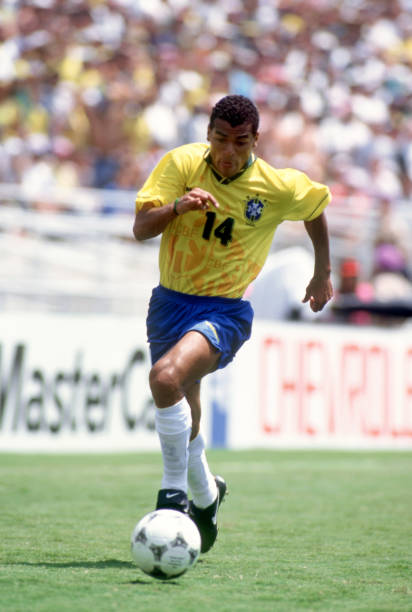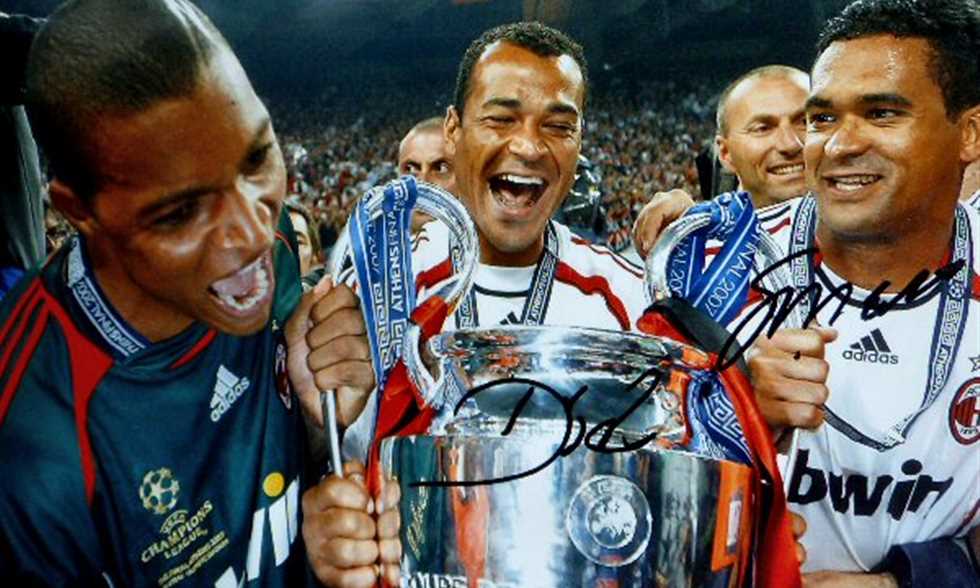CAFU: THE BORN WINNER WHO BECAME THE MOST COMPLETE FULL-BACK OF HIS TIME
Jamie Carragher’s light-hearted jibe at Gary Neville over his career as a full-back on an episode of Monday Night Football, where he claims that no young footballer aspires to grow up and become a full-back, wasn’t too far from the truth. A position whose importance has often been neglected, it isn’t always the most fascinating prospect - but in Brazil, the land where all forms of football are beautiful, it is a different story.
Since gaining an international reputation for their aptitude in the sport, they’ve produced the world’s best in the role. Carlos Alberto and Marinho Chagas dominated the flanks in the 1970s, Flamengo pair Leandro and Júnior earned that status in the 1980s, Maicon and Dani Alves carried the superiority in the 21st century, while Marcelo and Alex Sandro are modern-day heroes of the role. In the middle of these generations, however, came two players who revolutionized the role; one being the powerful and adventurous Roberto Carlos, and the
other being the iconic Cafu, who would become Brazil’s most capped footballer ever.
Born in 1970 – the same year Brazil won their third World Cup and became the sport’s most successful nation – Cafu cited his birth year as his inspiration for becoming a footballer. Growing up in the rough streets of Jardim Irene – one of the poorest regions in the city – taught him to never give up. It was a lesson he carried throughout life, as local giants São Paulo FC snapped him up as an 18-year-old following a series of rejections from some of the country’s other big clubs, including Palmeiras and Santos.
This was Cafu, in development.
Cafu owes a lot of his success to the legendary Telê Santana, the revolutionary Brazilian coach who is renowned for bringing the attacking mind back to Samba football, spectacularly displayed in Brazil’s iconic 1982 World Cup side. His methods invited Cafu to switch from being a right midfielder to a right-back - which was one of the most innovative moves in Brazilian football history.
Santana’s influence gave São Paulo a gem as Cafu’s ability to burst down the right side provided an extra, effective outlet in attack. Cafu settled in well and earned a surprise call-up to the national team in 1990, which would commence a historic career of national service to his beloved Brazil.
Two years later, he
cemented himself as one of the world’s finest full-backs in a matured display as São Paulo dispatched Palmeiras 4-2 in the first-leg of the final in Brazil’s top tier. He was involved in all four goals, scoring one – a stunning volley with his weaker left foot – assisting two and winning the penalty for the fourth. A week later they overcame Johan Cruyff’s Barcelona, the champions of Europe, to win the Intercontinental Cup as Cafu’s honours list continued to grow.
By the time he turned 24, he already had two Copa Libertadores, Intercontinental Cups and Campeonato Paulista honours to his name, around 30 national caps, and was building a great reputation for his exploits down the right flank. Although he lacked finesse to his crosses, he was well-renowned for
his dangerous overlapping runs, which offered another outlet down the right flank and made São Paulo such a potent attacking force. It bore fruit as he was given a spot in the squad for the Brazil side travelling to the United States for the 1994 World Cup, where he would achieve his greatest success to date.
In a side filled with champions from around the globe Brazil were favorites to go all the way. Still only 24, Cafu played second fiddle to the more experienced Jorginho as Brazil would make it all the way to the final against Italy. As fate would have it, he would spend more time on the pitch as Jorginho pulled up within the first 20 minutes, giving Cafu the chance to strut his stuff. His side would keep a clean sheet and subsequently overcome the Azzurri on penalties to win their fourth World Cup.
This was Cafu, in progression.
Gone were the days when he struggled to adapt to his defensive duties or plug-in pin-point crosses, and
in came a period where he was amongst the best footballers on the planet.
In 1997, with his status as Brazil’s first choice right-back now cemented, he would taste more success on the international scene at the 1997 Copa América in Bolivia. Brazil steamrolled their opposition match after match, and the now-ripe Cafu
earned a return to Europe with Roma which gave a greater audience a glimpse of his South American flair down the right flank.
If Cafu’s South American education under coaches like Santana and Parreira had taught him a lot about attacking football, he was about to enter a whole different world in Rome. The coach Zdeněk Zeman has always made good use of full-backs, and this was perfect for Cafu as
his liking for darting forward was utilised perfectly.
Following his season in Rome, Cafu went into the ’98 World Cup in which Brazil would be at their sparkling best again. The attacking trifecta of Ronaldo, Rivaldo and Bebeto led their charge, but right at the start of the tournament, it was Cafu who did the job at the other end of the pitch. Playing under the shining sun with the scores level at 1-1 against Scotland, it was Cafu’s strike that gave Brazil the win in their opening game.
Cafu was a permanent fixture in the side, playing in every game as as Brazil marched through the group and knockout rounds, overcoming Chile and Denmark in the round of 16 and quarter-finals, but Cafu’s successive bookings meant that he would miss the game against Holland in the semi-finals.
The final in Saint-Denis was a completely different story as France, led by Zinedine Zidane, outclassed Brazil in one of the most one-sided finals in World Cup history. The damning result saw Brazil in heartbreak, but Cafu would head back to Rome, where he and Fabio Capello would make history following the departure of Zeman.
This was Cafu, in transition.
Capello’s first season saw their rivals across the city claim the title in stunning fashion as Lazio, with the impressive Sven-Göran Eriksson and Pavel Nedvěd, triumphed over Juventus by a point. The following year, however, saw a brilliant Roma side earn what they thoroughly deserved.
Cafu was part of a great attacking outfit as Capello’s effective use of his forwards Francesco Totti, Vincenzo Montella and top-scorer Gabriel Batistuta saw them beat Juventus to the title by two points with a mammoth 68 goals.
Cafu was moved into a more advanced wing-back role and became one of the most important cogs in the team, along with Frenchman Vincent Candela down the left wing.
Running up and down the flank, galloping past opponents with speed and ferocity, was the norm at the Stadio Olimpico as Cafu’s reputation continued to grow. A fearsome sight on the ball, he made overlapping runs at every opportunity, while his partnership with his attackers continued to improve as the season went on.
In the summer preceding the title win, Roma had splashed out a massive £50 million, bringing in Walter Samuel in defence, Emerson to rampage around the middle of the park, and Batistuta to put the ball in the net. But it was Cafu, who for 90 minutes every week roamed up and down the pitch to strengthen both halves, who was critical in helping them win their first Scudetto in 18 years.
The following year would be the grandest event in football, the 2002 World Cup, which would be 103-cap Cafu’s third and first as captain.
Scolari used Cafu just as effectively as Capello, with his back-three system bringing the best out of his captain, who was used primarily as a wing-back. Once again, Cafu’s efficiency and energy were utilised as he played every second of the campaign – exactly what’s expected of a captain – and his troops charged through the competition to throw away the demons of France 98.
The final against Germany, a team that hardly featured any world beaters bar Michael Ballack, was a tense affair. This German side was unlike any of their predecessors and stumbled their way to the final, where their defensive resistance was halted by the heroics of Ronaldo. The Player of the Tournament scored his seventh and eighth of the finals and etched his name in history, giving Brazil their fifth world title.
In what was already a historic night for Cafu, where he became the first player in the history of the sport to participate in three successive World Cup finals, he had the proud moment of hoisting the prestigious trophy closer to the skies. While he did so, he didn’t forget home, having engraved the words “100% Jardim Irene” on his match-worn shirt.
This significant image is still on display all over Brazil, as the captain became an inspiration all over the country.
This was Cafu, an icon.
He had morphed into a hero and a champion. Cafu was on the move again a year after the World Cup for the giant of AC Milan. The Champions League – the pinnacle of club football – was his final motive, having won everything he possibly could have. The 2004 Scudetto was an added bonus, but the first chance at hoisting the game’s biggest club prize came in 2005, when AC Milan, having overcome so many great sides throughout the competition, reached the final and showed their mettle again – but only for 45 minutes.
Barcelona, Manchester United, Inter Milan and PSV were all taken apart, and for the first half, Liverpool seemed like a walk in the park, with Milan going into half-time in Istanbul with one hand on the trophy. But their six-minute collapse threw away glory, as a Steven Gerrard-led Liverpool hoisted the trophy on a dramatic night.
The Rossoneri were only good enough to challenge in Serie A but lacked the extra spark to capture another Scudetto. Nevertheless, just two years later, Carlo Ancelotti’s European pedigree was on complete display again, as Milan took apart the finest across the continent to make it to the final, once again against Liverpool, offering Cafu another shot at redemption.
With the experience of Paolo Maldini, Alessandro Costacurta, Filippo Inzaghi and Cafu himself amongst their ranks, they strolled to a win, with Inzaghi scoring in his typical poacher’s style to give Milan their seventh European honour, and for Cafu, a moment of personal satisfaction as he achieved everything he had dreamt of so late in his esteemed career.
In between this came the World Cup, where he had the armband and a nailed-down starting spot at right-back again – a great achievement for a 36-year-old. France and Zidane would be their nemesis once more, as Cafu bowed out at a stage that wasn’t the final for the first time, albeit with his head held very high.
A record-breaking 142 caps meant that he was the country’s most capped footballer ever and he has every reason to be proud of his career. Two Serie A titles, two Italian and European Super Cups, a Club World Cup and entries into both the Roma and AC Milan Halls of Fame were added in his time in Italy, and they are moralities he can be proud of.
He’s an equally classy figure off the pitch, giving back to his beloved Jardim Irene by opening the Cafu Foundation, a centre for sports and recreational activities which looks to give underprivileged kids and families a new lease of life. He is Brazil through and through. A winner, a role model, an icon and a gentleman, Cafu embodies the spirit of sport and the spirit of his country.
This is Cafu, a legend.







